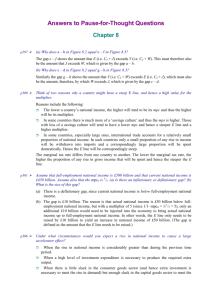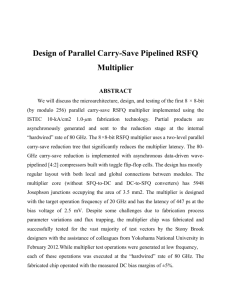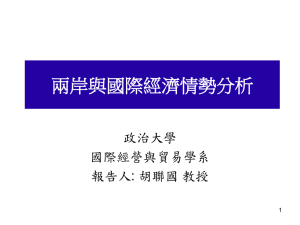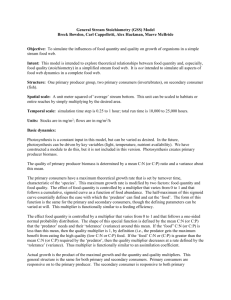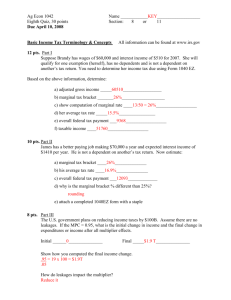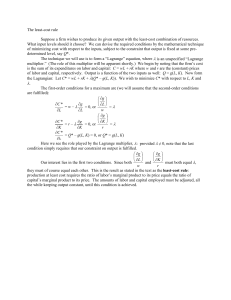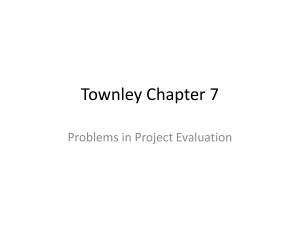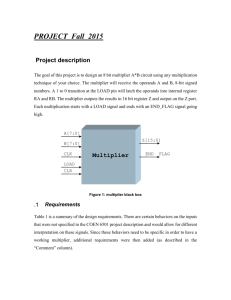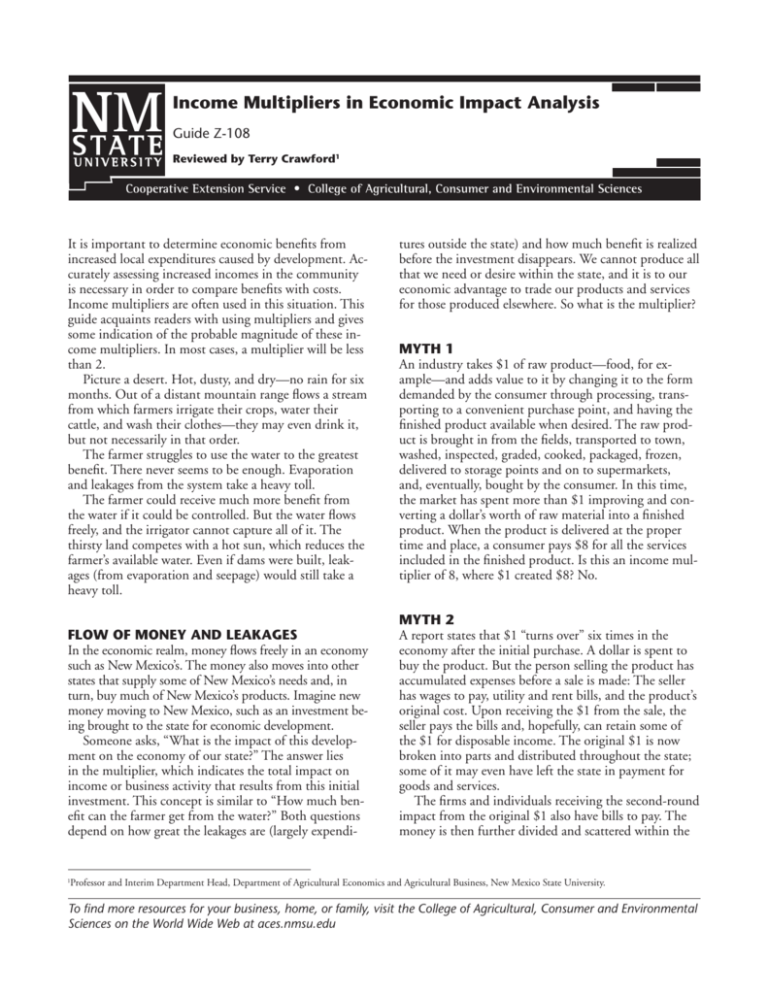
Income Multipliers in Economic Impact Analysis
Guide Z-108
Reviewed by Terry Crawford1
Cooperative Extension Service • College of Agricultural, Consumer and Environmental Sciences
It is important to determine economic benefits from
increased local expenditures caused by development. Accurately assessing increased incomes in the community
is necessary in order to compare benefits with costs.
Income multipliers are often used in this situation. This
guide acquaints readers with using multipliers and gives
some indication of the probable magnitude of these income multipliers. In most cases, a multiplier will be less
than 2.
Picture a desert. Hot, dusty, and dry—no rain for six
months. Out of a distant mountain range flows a stream
from which farmers irrigate their crops, water their
cattle, and wash their clothes—they may even drink it,
but not necessarily in that order.
The farmer struggles to use the water to the greatest
benefit. There never seems to be enough. Evaporation
and leakages from the system take a heavy toll.
The farmer could receive much more benefit from
the water if it could be controlled. But the water flows
freely, and the irrigator cannot capture all of it. The
thirsty land competes with a hot sun, which reduces the
farmer’s available water. Even if dams were built, leakages (from evaporation and seepage) would still take a
heavy toll.
FLOW OF MONEY AND LEAKAGES
In the economic realm, money flows freely in an economy
such as New Mexico’s. The money also moves into other
states that supply some of New Mexico’s needs and, in
turn, buy much of New Mexico’s products. Imagine new
money moving to New Mexico, such as an investment being brought to the state for economic development.
Someone asks, “What is the impact of this development on the economy of our state?” The answer lies
in the multiplier, which indicates the total impact on
income or business activity that results from this initial
investment. This concept is similar to “How much benefit can the farmer get from the water?” Both questions
depend on how great the leakages are (largely expendi-
tures outside the state) and how much benefit is realized
before the investment disappears. We cannot produce all
that we need or desire within the state, and it is to our
economic advantage to trade our products and services
for those produced elsewhere. So what is the multiplier?
MYTH 1
An industry takes $1 of raw product—food, for example—and adds value to it by changing it to the form
demanded by the consumer through processing, transporting to a convenient purchase point, and having the
finished product available when desired. The raw product is brought in from the fields, transported to town,
washed, inspected, graded, cooked, packaged, frozen,
delivered to storage points and on to supermarkets,
and, eventually, bought by the consumer. In this time,
the market has spent more than $1 improving and converting a dollar’s worth of raw material into a finished
product. When the product is delivered at the proper
time and place, a consumer pays $8 for all the services
included in the finished product. Is this an income multiplier of 8, where $1 created $8? No.
MYTH 2
A report states that $1 “turns over” six times in the
economy after the initial purchase. A dollar is spent to
buy the product. But the person selling the product has
accumulated expenses before a sale is made: The seller
has wages to pay, utility and rent bills, and the product’s
original cost. Upon receiving the $1 from the sale, the
seller pays the bills and, hopefully, can retain some of
the $1 for disposable income. The original $1 is now
broken into parts and distributed throughout the state;
some of it may even have left the state in payment for
goods and services.
The firms and individuals receiving the second-round
impact from the original $1 also have bills to pay. The
money is then further divided and scattered within the
Professor and Interim Department Head, Department of Agricultural Economics and Agricultural Business, New Mexico State University.
1
To find more resources for your business, home, or family, visit the College of Agricultural, Consumer and Environmental
Sciences on the World Wide Web at aces.nmsu.edu
spent. But using this figure as the income multiplier
ignores the fact that each time money turns over, the
amount retained within the state is reduced. Leakages
rapidly diminish the amount of each $1 retained in the
state’s economy.
Unfortunately, many economists (professional and
otherwise) have used the value-added and turnover concepts loosely, often implying they represent multipliers.
Figure 1. Example of a multiplier compared with turnover and
value-added.
state, and again some is lost in leakages outside the state.
This process continues until we can no longer measure
the impact of this $1 sale. Let’s suppose it took 6 rounds
of bill payments to lose this $1 to leakages outside New
Mexico. Was the multiplier 6? No.
EXPLANATION OF MYTHS
The first myth illustrates “value-added”—the increase
in value resulting from doing something to or with the
product. Each handler of the goods does something
useful, which makes the product more valuable. In measuring the relative economic importance of an industry,
value-added is useful because it measures that industry’s
contribution to the gross product of the economy. However, it is not a multiplier.
The second myth illustrates “turnover,” which tells
the average number of times $1 changes hands as it is
THE REAL MULTIPLIER
As money is expended in the state’s channels of business,
it changes hands several times. To measure the multiplier effect, we must focus on how much total business
or income results from the original expenditure. The
individuals and businesses receiving a payment return
it to the income stream as payment of expenses. At this
point, the all-important leakages emerge. When an
individual or a business returns dollars to the income
stream, they return part within the state and part outside. The portion spent outside no longer creates more
business or income within the state.
The individual creates leakages by saving a portion of
income before spending the rest, or by spending some
outside the state on vacations, insurance, federal tax,
mail-order purchases, and other such things. The business has expenses that result in leakages—the supplier of
goods may be out of state or there may be federal taxes to
pay. As suppliers are paid, the money tends to move out
of state because most goods sold in New Mexico are produced in other states. A major portion of the retail price
of an item is accounted for by people down the line from
the retailer, many of whom are outside New Mexico.
The portions of the money retained within the state
determine the true multiplier.
To calculate the total economic impact of an original
investment, add the amounts returned each time to the
income stream until the return reaches 0. Figure 1 is an
attempt to visualize this process, and illustrates valueadded, turnover, and a multiplier. The value-added may
be found in the breakdown of the original $1 expenditure. The $1 represents expenditure for the acquisition
of the raw materials, labor, packaging materials, etc.
“Value-added” is the change in value (85 cents occurring
within the state) before the first turnover. In this situation, 85 cents represents the profit and expenses that are
incurred leading to the first “turnover.”
The first turnover results in 60 cents going outside
the state, representing, perhaps, federal taxes, purchases
of heavy equipment, chemicals, insurance, or raw materials. The remaining 40 cents is the portion retained
within the state for wages and salaries, state and land
taxes, raw materials, rent, or interest on mortgages. Sub-
Guide Z-108 • Page 2
sequent turnovers represent similar transactions as some
money leaves and some stays.
The multiplier is the original $1 purchase and the
part of the $1 that remains within the state on the various turnovers—first $1 remains, then 40 cents, then 15
cents, then 6 cents, then 2 cents, and finally 1 cent. At
this point, it is difficult to measure further impact from
the expenditure of the original $1.
The multiplier varies by industries and regions. Generally, the smaller an area of concern or the less self-sufficient, the smaller the multiplier. Also, some industries
are much more dependent on the local area for materials
and labor than others.
The size of the multiplier is not the sole criterion
to use in evaluating an industry. The total number of
dollars of business sales also plays an important role. A
hot-dog stand may have a high multiplier and a pulp
plant a much lower one, but volume influences the total
economic impact within the region.
At the state level, most income multipliers vary from
1 to a maximum of 4 or 5 in extreme instances. Most
estimates would fall between 1 and 2.
A rough rule of thumb would be that the total economic impact on income within a state is less than twice
the original new income. A multiplier that exceeds 2
should be subjected to critical review before acceptance
or use in further analyses.
Original author: Robert O. Coppedge, Economic Development
Specialist. This NMSU Extension publication was originally
number 400 X-5. This information was revised and adapted by
Robert O. Coppedge from an earlier version published at Oregon
State University by Robert O. Coppedge and Russell C. Youmans.
DETERMINING A GENERAL MULTIPLIER
The following formula gives a general income multiplier
for a state or area when new income is introduced. The
number obtained can then be multiplied by the original
income to give the total economic impact on income in
the defined area.
Income multiplier = 1 / 1 - (x)(y)(z)
Where x is the percentage of the new income a consumer will spend rather than save, y is the percentage of
consumer expenditures made in the state, and z is the
percentage of business expenditures made in the state.
Thus, if we have a general knowledge of spending
patterns, we can approximate x, y, and z and obtain a
reasonable estimate of the multiplier.
For example, assume that a person spends 90% of an
addition to his or her income, and spends about 80%
of that 90% in the state. The business where this individual buys goods must obtain most of its goods from
out-of-state sources. Therefore, the business retains in
state about 40% of what the consumer spends. Taking
these estimates:
Income multiplier = 1 / 1 - (0.80)(0.90)(0.40) = 1.4
What this says is that if $100 of new income are
introduced to the state’s economic stream, the final
economic impact would be $140, which includes the
original $100.
Guide Z-108 • Page 3
Terry Crawford is a Professor and
Interim Department Head of the
Department of Agricultural Economics
and Agricultural Business at New Mexico
State University. He earned his Ph.D.
at Cornell University. His research and
teaching interests include economic policy,
marketing, prices, commodity economics,
and international trade.
Contents of publications may be freely reproduced for educational purposes. All other rights reserved. For permission to use
publications for other purposes, contact pubs@nmsu.edu or the authors listed on the publication.
New Mexico State University is an equal opportunity/affirmative action employer and educator. NMSU and the U.S. Department
of Agriculture cooperating.
Revised July 2011
Las Cruces, NM
Guide Z-108 • Page 4


